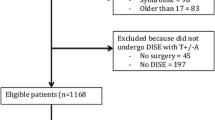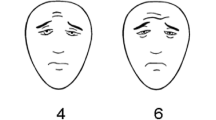Abstract
Purpose
Preoperative sleep study helps to predict post-adenotonsillectomy morphine requirements. However, in some institutions, many suspected children with obstructive sleep apnoea syndrome have an adenotonsillectomy without polysomnography assessments. This study investigated the relationship between the results of a fentanyl test performed before extubation and the postoperative morphine requirements in children after adenotonsillectomy.
Methods
Intravenous fentanyl (1 µg/kg) was given as a test before extubation when spontaneous ventilation was restored in 80 children aged 3–7 years who underwent adenotonsillectomy. The result was considered positive if the patient’s respiratory rate decreased >50% after the test. In the recovery room, pain was assessed every 10 min using the Children’s Hospital of Eastern Ontario Pain Scale. Rescue morphine (10 µg/kg) was given when the score was ≥6.
Results
The median [IQR (range)] cumulative morphine consumption rates for children with a positive result (n = 25) and a negative result (n = 52) were 30 (20, 40) and 50 (40, 50) µg/kg, respectively (P = 0.002). Eighty-eight percent of the positive-result patients and 48% of the negative-result patients were light consumers of morphine (cumulative dose <50 µg/kg) (P = 0.001).
Conclusions
We conclude that children with a positive result after a fentanyl test require less morphine to achieve comfort than those with a negative result.
ClinicalTrials.gov ID
NCT02484222.


Similar content being viewed by others
References
Parker NP, Walner DL. Trends in the indications for pediatric tonsillectomy or adenotonsillectomy. Int J Pediatr Otorhinolaryngol. 2011;75:282–5.
Brown KA, Laferriere A, Lakheeram I, Moss IA. Recurrent hypoxemia in children is associated with increased analgesic sensitivity to opiates. Anesthesiology. 2006;105:665–9.
Raghavendran S, Bagry H, Detheux G, Zhang X, Brouillette RT, Brown K. An anesthetic management protocol to decrease respiratory complications after adenotonsillectomy in children with severe sleep apnea. Anesth Analg. 2010;110:1093–101.
Mitchell RB, Pereira KD, Friedman NR. Sleep-disordered breathing in children: survey of current practice. Laryngoscope. 2006;116:956–8.
Weatherly RA, Mai EF, Ruzicka DL, Chervin RD. Identification and evaluation of obstructive sleep apnea prior to adenotonsillectomy in children: a survey of practice patterns. Sleep Med. 2003;4:297–307.
Davis JJ, Swenson JD, Hall RH, Dillon JD, Johnson KB, Egan TD, Pace NL, Niu SY. Preoperative “fentanyl challenge” as a tool to estimate postoperative opioid dosing in chronic opioid-consuming patients. Anesth Analg. 2005;101:389–95.
Stewart DW, Ragg PG, Sheppard S, Chalkiadis GA. The severity and duration of postoperative pain and analgesia requirements in children after tonsillectomy, orchidopexy, or inguinal hernia repair. Pediatr Anesth. 2012;22:136–43.
Brouillette RT, Morielli A, Leimanis A, Waters KA, Luciano R, Ducharme FM. Nocturnal pulse oximetry as an abbreviated testing modality for pediatric obstructive sleep apnea. Pediatrics. 2000;105:405–12.
Canto de Luca G, Singh V, Major MP, Witmans M, El-Hakim H, Major PW, Flores-Mir C. Diagnostic capability of questionnaires and clinical examinations to assess sleep-disordered breathing in children: a systematic review and meta-analysis. J Am Dent Assoc. 2014;145:165–78.
Chervin RD, Hedger K, Dillon JE, Pituch KJ. Pediatric sleep questionnaire (PSQ): validity and reliability of scales for sleep-disordered breathing, snoring, sleepiness, and behavioral problems. Sleep Med. 2000;1:21–32.
Author information
Authors and Affiliations
Corresponding author
Ethics declarations
Conflict of interest
All authors have no conflict of interest.
About this article
Cite this article
Li, YH., Wang, X., Zhou, ZJ. et al. Association between fentanyl test results and rescue morphine requirements in children after adenotonsillectomy. J Anesth 32, 77–81 (2018). https://doi.org/10.1007/s00540-017-2433-0
Received:
Accepted:
Published:
Issue Date:
DOI: https://doi.org/10.1007/s00540-017-2433-0




